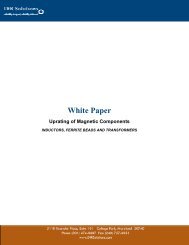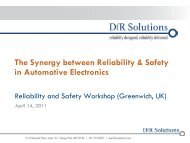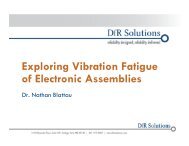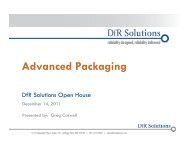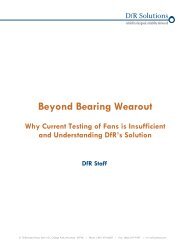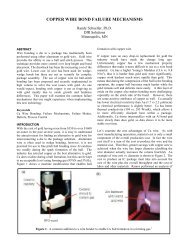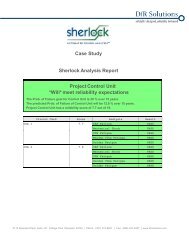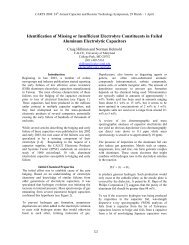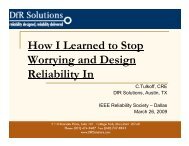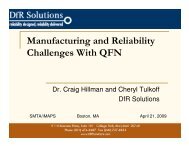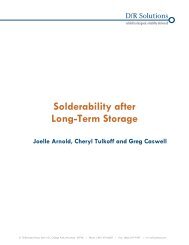Epidemiological Study on Sn-Ag-Cu Solder - DfR Solutions
Epidemiological Study on Sn-Ag-Cu Solder - DfR Solutions
Epidemiological Study on Sn-Ag-Cu Solder - DfR Solutions
- No tags were found...
Create successful ePaper yourself
Turn your PDF publications into a flip-book with our unique Google optimized e-Paper software.
EPIDEMIOLOGICAL STUDY ON SN-AG-CU SOLDER: BENCHMARKINGRESULTS FROM ACCELERATED LIFE TESTINGCraig Hillman, Nathan Blattau, Ed Dodd, and Joelle Arnold<strong>DfR</strong> Soluti<strong>on</strong>sCollege Park, MD, USAaskdfr@dfrsoluti<strong>on</strong>s.comABSTRACTThis paper will present the results of a comprehensiveoverview of accelerated life testing (ALT) of comp<strong>on</strong>entsassembled with <strong>Sn</strong><strong>Ag</strong><strong>Cu</strong> solder. Over 100 privatedocuments and published articles were assessed for data <strong>on</strong><strong>Sn</strong><strong>Ag</strong><strong>Cu</strong> performance under temperature cycling. Data <strong>on</strong>test parameters, comp<strong>on</strong>ent materials and design, andinterc<strong>on</strong>nect dimensi<strong>on</strong>s were acquired and results weregrouped by attach geometry, including leadless (i.e., ChipResistors), stiff lead (i.e., Alloy 42), and solder ball (i.e.,CSP, BGA). A particular emphasis was placed <strong>on</strong> obtainingtemperature cycling data over a wide range of dwell times(5 to 360 minutes). Discussi<strong>on</strong>s will focus <strong>on</strong> trends inperformance and will provide organizati<strong>on</strong>s that design,manufacture, or use Pb-free products first-pass expectati<strong>on</strong>sof times to failure under standard industry and military testspecificati<strong>on</strong>s.Key words: <strong>Sn</strong><strong>Ag</strong><strong>Cu</strong>, SAC, Pb-free, leadfree, chip resistor,2512, 1206, thin scale outline package, TSOP, Alloy 42,chip scale package, CSP, ball grid array, BGA, temperaturecycling, dwell timeINTRODUCTIONEpidemiology is defined as the scientific study of factorsaffecting the health of various populati<strong>on</strong>s. The purpose ofan epidemiological study is to predict thebehavior/survivability when a particular populati<strong>on</strong> issubjected to stressful c<strong>on</strong>diti<strong>on</strong>s (envir<strong>on</strong>ment, disease,etc.). With the recent transiti<strong>on</strong> of c<strong>on</strong>sumer/commercialproducts to Pb-free solder and the growing c<strong>on</strong>siderati<strong>on</strong> ofPb-free solder for applicati<strong>on</strong>s with high-reliabilityrequirements (industrial c<strong>on</strong>trols, avi<strong>on</strong>ics, military), thereis a critical need to collate and review the results of existingreliability studies with the end result providing expectati<strong>on</strong>sof time to failure under standard accelerated test c<strong>on</strong>diti<strong>on</strong>s.A ‘test-to-spec’ approach, where units are subjected tostandard industry/military test specificati<strong>on</strong>s and no failuresare expected, is not best practice in ensuring l<strong>on</strong>g-termreliability of electr<strong>on</strong>ics. For each new technology, newdesign or new operating envir<strong>on</strong>ment, a reliabilityassessment using validated physics of failure (PoF) basedmodels [1-3] should be performed. This assessment wouldbe performed for a realistic worst-case field envir<strong>on</strong>mentand the accelerated test envir<strong>on</strong>ment and the end resultwould be two time-to-failure predicti<strong>on</strong>s. The resulting ratioof time-to-failure in the field over time-to-failure during testprovides an accelerati<strong>on</strong> factor. This accelerati<strong>on</strong> factor canthen be used to design a life test with optimum efficiency.The product would then experience the same level ofstresses expected over the design life and the risk ofunderstressing the design or inducing irrelevant failureswould effectively drop to zero.Unfortunately, the reality of the electr<strong>on</strong>ics industry is that<strong>on</strong>ce a product qualificati<strong>on</strong> schedule is developed byinternal quality/reliability pers<strong>on</strong>nel, modificati<strong>on</strong>s inregards to the type of testing or test parameters are rarelyperformed. This inertia often results in a surprising amountof c<strong>on</strong>sternati<strong>on</strong> and delay in product release when failuresare detected during testing. The major motivati<strong>on</strong> for thispaper therefore was to avoid this scenario by allowingquality/reliability engineers/technicians to review the designand the planned accelerated life test (ALT) and to quicklydetermine if there is a reas<strong>on</strong>able risk that a Pb-free productmay experience failure. If failure may occur, PoF models forPb-free solders could then be used to c<strong>on</strong>firm sufficientdesign life in the actual operating envir<strong>on</strong>ment.DATA GATHERINGThe primary focus during data gathering was time to failuredata for Pb-free solder under a variety of standard testc<strong>on</strong>diti<strong>on</strong>s. Time to failure data was categorized as twoparameterWeibull. Characteristic life (eta, time to 63%failure) was obtained either directly from the publicati<strong>on</strong> orderived from the raw data using Weibull++ (Reliasoft,Phoenix, AZ). The shape parameter (beta) was also obtainedwhen available.While a universal Pb-free solder has yet to be established,and may be unobtainable given the increasing interest in<strong>Sn</strong>Ni<strong>Cu</strong>X and SACX alloys, for greatest relevance the Pbfreesolder for this epidemiological study was limited to thetin-copper-silver (<strong>Sn</strong><strong>Ag</strong><strong>Cu</strong>) family. Specifically, aformulati<strong>on</strong> range of 4.0wt% to 3.0wt% <strong>Ag</strong> and 0.9wt% to0.5wt% <strong>Cu</strong>. The choice of alloy and compositi<strong>on</strong> was based<strong>on</strong> its dominance in the industry over the past five years andevidence from an IPC study that time to failure behaviorover this range was relatively c<strong>on</strong>sistent [4].Attempts to limit data collecti<strong>on</strong> to standard test c<strong>on</strong>diti<strong>on</strong>swas not an issue as even academic and research instituti<strong>on</strong>salmost exclusively perform testing in correlati<strong>on</strong> withindustry/military specificati<strong>on</strong>s. The majority of data wasobtained from thermal cycling testing, most likely because
this is the primary envir<strong>on</strong>mental stress for thec<strong>on</strong>sumer/computer applicati<strong>on</strong>s that initially transiti<strong>on</strong>ed toPb-free.While numerous comp<strong>on</strong>ents have been subjected to avariety of accelerated life tests, the focus of this study wasto identify and catalogue the behavior of comm<strong>on</strong>comp<strong>on</strong>ents that are the most susceptible to failure duringproduct qualificati<strong>on</strong>. These were identified as• Chip resistors (1206 and 2512 case sizes)• Thin scale outline packages (TSOP) with Alloy 42leadframe• Area array devices (ball grid array and chip scalepackages)Attempts to extract additi<strong>on</strong>al informati<strong>on</strong>, especially inregards to developing validati<strong>on</strong> data for PoF models, waslimited by the lack of a standard format for reportingreliability data. Numerous publicati<strong>on</strong>s failed to report themost basic of informati<strong>on</strong>, including comp<strong>on</strong>ent size, diesize, dwell times, ramp rates, board coefficient of thermalexpansi<strong>on</strong> (CTE), or other important design or materialsinformati<strong>on</strong>. Almost all the publicati<strong>on</strong>s failed to providedetails <strong>on</strong> the solder volume, such as board b<strong>on</strong>d paddimensi<strong>on</strong>s, stencil thickness, or solder joint height. Inadditi<strong>on</strong>, relevant procedural informati<strong>on</strong>, such asm<strong>on</strong>itoring or event detecti<strong>on</strong>, number of samples tested,number of samples failed, and validati<strong>on</strong> that failures werenot at other locati<strong>on</strong>s (such as vias), was often not providedin sufficient detail.This absence of data can be critical, as all predictive modelsfor l<strong>on</strong>g-term reliability of <strong>Sn</strong><strong>Ag</strong><strong>Cu</strong> solder depend <strong>on</strong> testresults to validate their output. Lack of reliable data canresult in a lack of reliable end-of-life models and shoulddrive professi<strong>on</strong>al organizati<strong>on</strong>s, such as SMTA, IEEE, IPC,and IMAPS, to c<strong>on</strong>sider a global specificati<strong>on</strong> <strong>on</strong> requireddata formats when reporting the results of reliability testing.The sec<strong>on</strong>d limitati<strong>on</strong> was the lack of repeatability.Repeatability and reproducibility (R&R) have become astandard practice in manufacturing to ensure a sufficientlevel of quality c<strong>on</strong>trol. While the cost and time associatedwith temperature cycling to failure can definitively hinderthe implementati<strong>on</strong> of R&R, it should be str<strong>on</strong>glyc<strong>on</strong>sidered as a review of the literature seems to identifyseveral examples of outliers that show very poor correlati<strong>on</strong>with test results from other publicati<strong>on</strong>s and may not berepeatable.TEMPERATURE CYCLINGUse of temperature cycling is the most comm<strong>on</strong> testc<strong>on</strong>diti<strong>on</strong> for product qualificati<strong>on</strong>. Heavy reliance <strong>on</strong> oldermilitary specificati<strong>on</strong>s has resulted in a comm<strong>on</strong> set of testparameters, including temperature range, dwell time, andramp rates. This standardizati<strong>on</strong> facilitated analysis andobservati<strong>on</strong>s of behavior trends. Severe temperature deltasare the most comm<strong>on</strong> accelerated life tests and primarilyc<strong>on</strong>sist of the following:• -55C to 125C• -40C to 125C• 0C to 100CSurprisingly, this investigati<strong>on</strong> found relatively fewexamples of -40 to 85C testing <strong>on</strong> Pb-free assemblies, eventhough this corresp<strong>on</strong>ds to an industrially rated comp<strong>on</strong>ent.Some examples of severe test c<strong>on</strong>diti<strong>on</strong>s with a maximumtemperature of 150C were also identified. These extremec<strong>on</strong>diti<strong>on</strong>s, minimum temperatures below -40C andmaximum temperatures above 125C, are often justified forthe applicability to the use envir<strong>on</strong>ment (e.g., under thehood). However, a broad review of test results underextreme envir<strong>on</strong>ments and comparis<strong>on</strong> to the more standard-40C to 125C suggests that these envir<strong>on</strong>ments do not resultin fewer cycles to failure.More benign c<strong>on</strong>diti<strong>on</strong>s, such as 40 to 100C, were lesscomm<strong>on</strong>, but were critical for extrapolati<strong>on</strong> of behaviors toc<strong>on</strong>diti<strong>on</strong>s more representative of field c<strong>on</strong>diti<strong>on</strong>s.Standardizati<strong>on</strong>, and the need for time efficiency, has alsoresulted in a limited range in dwell times of 5 to 15 minutes.Because of the increasing popularity of thermal shocktesting, there is a much broader range in ramp rates, from4C/min to 200C/min (claims of ramp rates greater than200C/min are unrealistic due to heat transfer and heatcapacity limitati<strong>on</strong>s). However, recent work dem<strong>on</strong>stratedthat ramp rates tend to have a negligible or sec<strong>on</strong>dary effectwhen compared to other envir<strong>on</strong>mental and comp<strong>on</strong>entparameters [3].Comparing the informati<strong>on</strong> retrieved from the variouspapers can be difficult as a number of experimental designswere setup to assess the influence of parameters separatefrom the comp<strong>on</strong>ent, interc<strong>on</strong>nect or envir<strong>on</strong>ment. Forexample, the dataset from Woodrow [6] included varyingthe Pb-free solderability plating between immersi<strong>on</strong> silver(Im<strong>Ag</strong>), organic solderability preservative (OSP), andelectroless nickel/immersi<strong>on</strong> gold (ENIG). A similar effortwas made by Schubert [14]. Other n<strong>on</strong>-envir<strong>on</strong>mentaldrivers investigated included cooling rates [10] and thenumber of reflows [13]. In additi<strong>on</strong>, some experimentalcoup<strong>on</strong>s c<strong>on</strong>sisted of test boards with thicknesses less than60 mil. For medium to large comp<strong>on</strong>ents, a thinner boardintroduces additi<strong>on</strong>al compliance into the test system,resulting in a n<strong>on</strong>-pertinent extensi<strong>on</strong> in time to failure.Leadless / Stiff LeadTwo packaging styles most susceptible to failures duringtemperature cycling are leadless comp<strong>on</strong>ents andcomp<strong>on</strong>ents with stiff leadframes (e.g., Alloy42 leadframe).These comp<strong>on</strong>ents also tend to provide a narrower spreaderof failure data and easier trend spotting because there isminimal variati<strong>on</strong> in packaging materials or geometry.Characteristic life as a functi<strong>on</strong> of change in temperature,∆T, for leadless chip resistors and TSOPs with Alloy42
leadframes are displayed in Figure 1 and Figure 2,respectively. While data was obtained for both 1206 (120mil length by 60 mil width) and 2512 (250 mil length by120 mil width) case sizes, the lack of test data at below-40C to 125C for the 1206 case size limited extrapolati<strong>on</strong> tothe 2512 case size.Characteristic Life (Cycles to Failure)1000090008000700060005000400030002000100000 50 100 150 200Change in Temperature ( o C)Type 1 Type 21206 Case Size2512 Case Size Figure 3: Type 1 and Type 2 TSOP package styles.Characteristic life, however, is not a particularly valid pointof reference for product qualificati<strong>on</strong> as very feworganizati<strong>on</strong>s are willing to test product until 63.2% fail. Amore relevant parameter would be to identify when wearoutcould initiate given the relatively low number of samplesoften subjected to product qualificati<strong>on</strong> (anywhere from 3 to77). Given the low number of samples and the low degree ofc<strong>on</strong>fidence in extrapolati<strong>on</strong>s to 1%, a more relevantpredicti<strong>on</strong> of first failure would be based <strong>on</strong> cycles to 10%failure.Figure 1: Cycles to failure as a functi<strong>on</strong> of change intemperature during thermal cycling for leadless chipresistors attached with SAC solder.Characteristic Life (Cycles to Failure)1000090008000700060005000400030002000100000 50 100 150 200Change in Temperature ( o C)Type 1Type 2Type N/AFigure 2: Cycles to failure as a functi<strong>on</strong> of change intemperature during thermal cycling for TSOPs with Alloy42leadframe attached with SAC solder.An initial review of the data identified several interestingfindings.• The time to failure behaviors for 2512 resistors andAlloy 42 TSOPs are very similar• For both 2512 and TSOP, cycles to failuredisplayed a power law dependence (-1.5) to ∆T.This c<strong>on</strong>forms to findings from previous studies• For Alloy 42 TSOPs, time to failure seemed to berelatively independent number of I/O (44 to 56leads) or package design (Type 1 or Type 2)(seeFigure 3)Weibull plots for cycles to failure for 2512 resistors andAlloy42 TSOPs are displayed in Figure 4 and Figure 5,respectively. The shape parameter, beta, allows forextrapolati<strong>on</strong> back from the characteristic life to time to10% failure. The average shape parameter for 2512 resistorswas 3.3, with a reported range of 1.7 to 5.6. The averageshape parameter for Alloy 42 TSOPs was slightly higher,7.7, with a broader range of 2.7 to 22. Based <strong>on</strong> theseWeibull characteristics, a realistic expectati<strong>on</strong> of first failureduring product qualificati<strong>on</strong> is displayed in Table 1.Reliability0.900.800.700.600.500.400.300.200.100 1000 2000 3000 4000 5000 6000Temperature CyclesFigure 4: Two parameter Weibull plots of 2512 resistorsattached using SAC solder and subjected to varioustemperature cycles (0C to 100C: 100; -40C to 125C: 165; -55C to 125C: 180).100100100100100165165165165180180190180180
Reliability0.900.800.700.600.500.400.300.200.100 1000 2000 3000 4000 5000 6000Temperature CyclesFigure 5: Two parameter Weibull plots of Alloy42 TSOPsattached using SAC solder and subjected to varioustemperature cycles (40C to 100C: 60; 0C to 100C: 100; -40C to 125C: 165; -55C to 125C: 180).An alternate way to read Table 1 is that Pb-free designsc<strong>on</strong>taining either 2512 chip resistors or Alloy42 TSOPsshould not be expected to survive more than 500 cycles of -40C to 125C or 1500 cycles of 0C to 100C. Internalspecificati<strong>on</strong>s that call out a higher number of cycles willlikely induce failure during product qualificati<strong>on</strong> and thesefailures will be due to inherent design limitati<strong>on</strong>s. On theother hand, if failures are observed significantly earlier thanthe specified number of cycles, this would str<strong>on</strong>gly suggestthe presence of manufacturing defects.Table 1: Estimated cycles to first failure during productqualificati<strong>on</strong>Temperature CyclePackage 0C to 100C -40C to 125C2512 1500 cycles 500 cyclesTSOP 1500 cycles 500 cyclesArea ArrayThe other packaging style of c<strong>on</strong>cern during temperaturecycling are those with area array interc<strong>on</strong>nects. Thisprimarily c<strong>on</strong>sists of ball grid arrays (BGAs) and chip scalepackages (CSPs). The point of differentiati<strong>on</strong> betweenBGAs and CSPs is not always well defined other than CSPsc<strong>on</strong>tain a die that is 80% or greater than the total area of thepackage. As a general statement, CSPs tend to be smaller,have fewer I/O, and have a finer pitch. However, since thisstudy categorized based <strong>on</strong> authors’ descripti<strong>on</strong>s, there wassome overlap in terms of number of I/O (144 pin BGA; 169pin CSP) and pitch (0.65 mm pitch BGA; 0.8 mm pitchCSP).Characteristic life as a functi<strong>on</strong> of ∆T for plastic BGAs(PBGAs), flex and ceramic BGAs, and CSPs are displayedin Figure 6, Figure 7, and Figure 8, respectively. All thedata from CSPs were <strong>on</strong> n<strong>on</strong>-underfilled packages. Theaverage shape parameter was found to be approximately 9.76060100100100100100100100100165180180180180180180for BGAs and 6.2 for CSPs with both package styles havinga very broad range of reported values (2.5 to 30).Characteristic Life (Cycles to Failure)1000090008000700060005000400030002000100000 50 100 150 200Change in Temperature ( o C)Plastic 1.0Plastic N/AFigure 6: Cycles to failure as a functi<strong>on</strong> of change intemperature during thermal cycling for PBGAs attachedwith SAC solder. Colorati<strong>on</strong> identifies different pitches (lessthan 1.0 mm, 1.0 mm, greater than 1.0 mm, unknown).Characteristic Life (Cycles to Failure)16000140001200010000800060004000200000 50 100 150 200Change in Temperature ( o C)CeramicFlex 0.8Flex 1.0Flex N/AFigure 7: Cycles to failure as a functi<strong>on</strong> of change intemperature during thermal cycling for ceramic and flexBGAs attached with SAC solder. Colorati<strong>on</strong> identifiesdifferent pitches (0.8 mm, 1.0 mm, unknown).Characteristic Life (Cycles to Failure)1000090008000700060005000400030002000100000 50 100 150 200Change in Temperature ( o C)CSP 0.4CSP 0.5CSP 0.8CSP N/AFigure 8: Cycles to failure as a functi<strong>on</strong> of change intemperature during thermal cycling for CSPs attached withSAC solder. Colorati<strong>on</strong> identifies different pitches (0.4 mm,0.5 mm, 0.8 mm, unknown).
While the range in cycles to failure is much greater thanobserved with 2512 resistors or Alloy42 TSOPs, it isinteresting to note that the range is still within the claimedaccuracy of most physics of failure based models of 2X. Forexample, a PBGA experiences failure after 4500 cycles of -40C to 125C. A reliability model would be c<strong>on</strong>sidered to berelatively accurate if it predicted time to failure between2250 cycles and 9000 cycles. This is within the observablerange of all SAC solder PBGAs tested within the reportableliterature.The range of cycle to failure date for CSPs was especiallydisappointing as it would be assumed that the diecharacteristics (coefficient of thermal expansi<strong>on</strong>, elasticmodulus) would dominate behavior and time to failurecould segregated by package, and thus die, dimensi<strong>on</strong>s. Thelack of correlati<strong>on</strong> signals the str<strong>on</strong>g influence of theinterposer material and design in ensuring reliability.Since area array package design and materials are lessstandardized, and thus lead to a wider range of potentialfailure behavior, any observati<strong>on</strong> of behavior trends requirestracking <strong>on</strong>ly those datasets that c<strong>on</strong>tain at least twotemperature cycles. The characteristic life for these datasetswas normalized around the 0C to 100C thermal cycle andthe results are displayed in Figure 9.The area array devices were found to also display a powerlaw behavior in resp<strong>on</strong>se to changes in ∆T, but the best fitexp<strong>on</strong>ent is -2.7, as opposed to -1.5 for the 2512 resistor andAlloy42 TSOP.Normalized Characteristic Life765432100 50 100 150 200Change in Temperature ( o C)Figure 9: Normalized characteristic lifetime as a functi<strong>on</strong> ofchange in temperature for area array packages (BGAs andCSPs)Dwell TimeWhile there is an understanding within the reliabilitycommunity that the failure behavior of SAC solder is verydependent up<strong>on</strong> dwell time, surprisingly few experimentaldata points exist <strong>on</strong> the influence of l<strong>on</strong>g-term dwells <strong>on</strong>time to failure during temperature cycling. Only threepublicati<strong>on</strong>s have reported <strong>on</strong> the influence of dwell timesgreater than 30 minutes (Bartello, Henshall, Bath) and allthree publicati<strong>on</strong>s relied <strong>on</strong> a 0C to 100C thermal cycle.Due to this extremely limited dataset, the influence of l<strong>on</strong>gtermdwell was also assessed using results from finiteelement analysis of a 2512 chip resistor subjected to 25C to80C temperature cycling. Cycles to failure were calculatedbased <strong>on</strong> creep behavior derived from Schubert and adamage model from Syed (Blattau). Data from the fourexperimental and <strong>on</strong>e modeling results were normalized bycycles to failure for a 10 minute dwell. The results aredisplayed in Figure 10.Normalized Time to Failure1.21.00.80.60.40.2Pan, HiCTE CBGABartelo, CBGA0.00 100 200 300 400 500 600Dwell Time (minutes)Pan, CSPBath, PBGABlattau, 2512Figure 10: Normalized time to failure as a functi<strong>on</strong> of dwelltime at maximum temperature for SAC solder.Figure 10 dem<strong>on</strong>strates, as would be expected, that lowertemperatures and smaller differences in coefficient ofthermal expansi<strong>on</strong> (CTE) reduce the influence of dwell time<strong>on</strong> failure behavior. Under a worst-case scenario, such as alarge ceramic ball grid array reaching 100C, time to failurein the field (8 hour dwell) could be as much as 60% lessthan time to failure under test (10 minute dwell). However,under more benign c<strong>on</strong>diti<strong>on</strong>s, such as a plastic ball gridarray with a maximum temperature of 80C, extended dwellsmay <strong>on</strong>ly reduce time to failure by 25-30%.SAC vs. <strong>Sn</strong>PbThe initial purpose of this study was not to compare thereliability of SAC and <strong>Sn</strong>Pb c<strong>on</strong>necti<strong>on</strong>s, especially inregards to field performance. A more appropriatemethodology for this analysis would be to use physics offailure based reliability models. However, the plotting ofSAC behavior over l<strong>on</strong>g-term dwells in Figure 10 doesprovide the ability to provide a more relevant comparis<strong>on</strong>than has been offered in standard accelerated life tests.Relevant time to failure comparis<strong>on</strong>s require incorporati<strong>on</strong>of the effect of l<strong>on</strong>g-term dwell and extrapolati<strong>on</strong> of time to1% failure, as opposed to characteristic life. Theseinfluences were taken into c<strong>on</strong>siderati<strong>on</strong> and are plotted inFigure 11 and Figure 12. In each figure, the influence ofl<strong>on</strong>g-term dwells (8 hours) <strong>on</strong> SAC behavior was plotted asreducing time to failure to 75% (nominal) and 50% (worstcase)of short-term dwells (10 minutes).
Time to 1% Failure (Cycles)10000900080007000600050004000300020001000SAC (75%)<strong>Sn</strong>PbSAC (50%)SAC Life / <strong>Sn</strong>Pb Life2.52.01.51.00.500 20 40 60 80 100Change in Temperature ( o C)0.00 50 100 150 200Change in Temperature ( o C)Figure 11: Time to 1% failure for 2512 resistors attachedwith SAC or <strong>Sn</strong>Pb solder and subjected to l<strong>on</strong>g dwells(~8 hours).Figure 13: Ratio of SAC/<strong>Sn</strong>Pb reliability for area arraydevices as a functi<strong>on</strong> of change in temperature.2.5Time to 1% Failure (Cycles)1000090008000700060005000400030002000SAC (75%)<strong>Sn</strong>PbSAC (50%)SAC Life / <strong>Sn</strong>Pb Life2.01.51.00.5100000 20 40 60 80Change in Temperature ( o C)Figure 12: Time to 1% failure for Alloy42 TSOPs attachedwith SAC or <strong>Sn</strong>Pb solder and subjected to l<strong>on</strong>g dwells (~8hours).It can be seen that the superior robustness observed withSAC during accelerated life testing is for most parteliminated when the lower beta and degradati<strong>on</strong> duringl<strong>on</strong>g-term dwells is c<strong>on</strong>sidered. Given the expectedc<strong>on</strong>fidence bounds and degree of uncertainty, it is notunrealistic to state that the field failure behavior of SAC and<strong>Sn</strong>Pb assemblies will be roughly equivalent.Because of the wide variati<strong>on</strong> in BGA/CSP design andmaterials, a similar direct comparis<strong>on</strong> using accelerated lifetest data is not possible. However, as with Figure 9, arelative comparis<strong>on</strong> of SAC vs. <strong>Sn</strong>Pb reliability can beperformed. The ratio of SAC lifetime vs <strong>Sn</strong>Pb lifetime as afuncti<strong>on</strong> of ∆T for area array devices is displayed in Figure13 and Figure 14.1000.00 2000 4000 6000 8000 10000 12000 14000 16000Characteristic Life (Cycles)Figure 14: Ratio of SAC/<strong>Sn</strong>Pb reliability for area arraydevices as a functi<strong>on</strong> of characteristic lifetime of the SACcomp<strong>on</strong>ent.While there is no obvious <strong>on</strong>e-to-<strong>on</strong>e influence of ∆T <strong>on</strong>SAC/<strong>Sn</strong>Pb ratio, the green arrow in Figure 14 marks ageneral increase in SAC’s reliability over <strong>Sn</strong>Pb as the timeto failure increases. <strong>Ag</strong>ain, this makes sense based up<strong>on</strong> theexisting industry knowledge base. Lower maximumtemperatures and smaller mismatches in CTE result in anincrease in time to failure and reduce the creep c<strong>on</strong>stituentin the damage evoluti<strong>on</strong> in SAC.However, a different trend arises if we take into account theeffect of l<strong>on</strong>g-term dwell (25% reducti<strong>on</strong> in life) andextrapolate to 1% failure behavior. As shown in Figure 15and ignoring obvious outliers, the ratio of SAC-to-<strong>Sn</strong>Pbreliability seems to be relatively independent of time tofailure and in general shows a slight less than 1:1 ratio.
SAC / <strong>Sn</strong>Pb (Cycles to 1% Failure)10.01.00.11000 10000 100000Characteristic Life (Cycles)Figure 15: Ratio of SAC/<strong>Sn</strong>Pb time to 1% failure for areaarray devices as a functi<strong>on</strong> of characteristic lifetime of theSAC comp<strong>on</strong>ent and taking into account l<strong>on</strong>g-term dwell (8hours).VIBRATIONThere is currently an <strong>on</strong>going effort to complete anepidemiological study <strong>on</strong> the performance of SAC solderunder vibrati<strong>on</strong>. While this effort is more complex due tothe wide range of test c<strong>on</strong>diti<strong>on</strong>s and package geometriesselected for vibrati<strong>on</strong> testing, initial indicati<strong>on</strong>s seem tosuggest similar performance to <strong>Sn</strong>Pb.MECHANICAL SHOCKThere is currently an <strong>on</strong>going effort to complete anepidemiological study <strong>on</strong> the performance of SAC solderunder vibrati<strong>on</strong>, both with and without prec<strong>on</strong>diti<strong>on</strong>ingc<strong>on</strong>sisting of l<strong>on</strong>g-term aging. While a variety of packagestyles are subjected to mechanical shock, the recentadopti<strong>on</strong> of an industry standard, JESD22-B111 [47], allowsfor the str<strong>on</strong>ger likelihood of identificati<strong>on</strong> of definitivetrends.CONCLUSIONAs a result of extensive data gathering and analysis, severalimportant c<strong>on</strong>clusi<strong>on</strong>s regarding SAC reliability wereobtained:• As a general observati<strong>on</strong>, testing at temperatureshigher than 125C or lower than -40C does notresult in significantly fewer cycles to failure• 2512 chip resistors and TSOPs with Alloy42leadframes can not be expected to survive morethan 500 cycles of -40C to 125C and 1500 cyclesof 0C to 100C• Leadless and stiff leaded comp<strong>on</strong>ents display a-1.5 power law dependence <strong>on</strong> ∆T while area arraycomp<strong>on</strong>ents display a -2.7 power law behavior• The effect of l<strong>on</strong>g-term dwell, up to 8 hours, wouldbe expected to reduce lifetime by 40 to 60% duringtesting and 25 to 40% during field use• Once l<strong>on</strong>g-term dwell and differences in shapeparameters are taken into account, there is likely tobe no statistically measurable difference in time tofailure for SAC and <strong>Sn</strong>Pb assemblies over mostoperating envir<strong>on</strong>mentsREFERENCES1. Engelmaier , “Fatigue Life of Leadless Chip Carrier<strong>Solder</strong> Joints During Power Cycling,” IEEE CPMT,Sep 1983, Volume: 6, Issue: 3, pp 232- 2372. Clech, et. al., “A comprehensive surface mountreliability model covering severalgenerati<strong>on</strong>s ofpackaging and assembly technology,” IEEE CPMT,Dec 1993, Volume: 16, Issue: 8, pp 949-9603. Blattau, An Engelmaier Model for Leadless CeramicChip Devices with Pb-free <strong>Solder</strong>, IPC/JEDEC LeadFree C<strong>on</strong>ference, Santa Clara, CA, March 7-9, 20064. “Round Robin Testing and Analysis of Lead Free<strong>Solder</strong> Pastes with Alloys of Tin, Silver and Copper:Final Report,” IPC <strong>Solder</strong> Products Value Council –Lead Free Technical Subcommittee, 20055. Suhling, et. al., “Thermal cycling reliability of lead freechip resistor solder joints”, <strong>Solder</strong>ing and SMT, vol. 16,no. 2, pp. 77–87, Jun. 2004.6. Woodrow, “Reliability and Leachate Testing of Lead-Free <strong>Solder</strong> Joints”, IPC APEX 20027. Swan, et. al. ,”Development of Lead-Free PeripheralLeaded and PBGA Comp<strong>on</strong>ents to Meet MSL3 at 260°C Peak Reflow Profile”, IPC APEX 20018. Unknown, RoHS Readiness, June 2004, update, Webbased9. Qi, et al., “Temperature profile effects in acceleratedthermal cycling of <strong>Sn</strong>Pb and Pb-free solder joints”,Microelectr<strong>on</strong>ics Reliability (2005)10. Qi, et. al., ”Accelerated Thermal Fatigue of Lead-Free<strong>Solder</strong> Joints as a Functi<strong>on</strong> of Reflow Cooling Rate”,Journal of Electr<strong>on</strong>ic Materials, Vol. 33, No. 12, 200411. Qi, et. al., ”Accelerated Thermal Cycling of Tin-Leadand Lead-Free <strong>Solder</strong> Joints”12. Dusek et. al., “Compatibility of Lead-Free Alloys with<strong>Cu</strong>rrent PCB Materials”, IMAPS 2002, pp. 110-11513. Dusek, et. al., “Effect of PCB Finish, Processing andMicrostructure <strong>on</strong> Lead-Free <strong>Solder</strong> Joint Reliability”,NPL Report, September 200514. Schubert et. al., IMAPS15. Dusek, et. al., “An Experimental Validati<strong>on</strong> ofModelling for Pb-free <strong>Solder</strong> Joint Reliability,” NPLReport, October 200116. Goodman, “Reliability and Failure Analysis: Review ofDirective 2002/95/EC (RoHS) Categories 8 and 9,Interim Report,” ERA Technology, March 200617. “Lead-Free Packaging for Semic<strong>on</strong>ductor Devices,” E4Presentati<strong>on</strong>, March 24, 200518. Hillman et. al., “JCAA/JG-PP No-Lead <strong>Solder</strong> Project:-55 to 125C Thermal Cycle Testing Final Report,” May28, 200619. Woodrow, “JCAA/JG-PP No-Lead <strong>Solder</strong> Project: -20C to 80C Thermal Cycle Test,” IPC APEX, February200620. Woodrow, “JCAA/JG-PP Lead-Free <strong>Solder</strong> Project:Thermal Shock Test,” March 1, 200621. Small Outline Package Guide, Intel, 1999
22. FPGA User’s Guide (Versi<strong>on</strong> 4.2), Spansi<strong>on</strong>,November 1, 200223. Gutowski, et. al, “WTEC Panel Report <strong>on</strong>Envir<strong>on</strong>mentally Benign Manufacturing,” Internati<strong>on</strong>alTechnology Research Institute, April 200124. Martens, et. al., “Recipe for Reliability in Wafer LevelPackaging,” 8 th Annual KGD Workshop, Napa,California, September 200125. Mawer, Plastic Ball Grid Array (PBGA), DocumentAN1231, Motorola, November 199626. Gleas<strong>on</strong>, et. al., “Pb-Free Assembly, Rework, andReliability Analysis of IPC Class 2 Assemblies,”Electr<strong>on</strong>ic Comp<strong>on</strong>ents and Technology, 2005. ECTC'05. Proceedings, 31 May-3 June 2005, pp 959- 96927. Bradley, “Lead-free solder assembly: impact andopportunity,” Electr<strong>on</strong>ic Comp<strong>on</strong>ents and TechnologyC<strong>on</strong>ference, 2003. Proceedings. 53 rd , May 27-30, 2003,pp 41- 4628. Pan et. al., “An Accelerati<strong>on</strong> Model for <strong>Sn</strong>-<strong>Ag</strong>-<strong>Cu</strong><strong>Solder</strong> Joint Reliability Under Various Thermal CycleC<strong>on</strong>diti<strong>on</strong>s,” SMTAI 200529. Che, et. al., “Lead free solder joint reliabilitycharacterizati<strong>on</strong> for PBGA, PQFP and TSSOPassemblies,” Electr<strong>on</strong>ic Comp<strong>on</strong>ents and Technology,2005. ECTC '05. Proceedings, 31 May-3 June 2005, pp916- 92130. Wulfert, “Risks and opportunities of Pb-free solderterminals and packaging for processability at elevatedtemperatures,” Freescale, September 200431. Solberg, et. al., “IC package qualificati<strong>on</strong> testing forlead-free soldering,” Global SMT and Packaging, May200632. Vandevelde, et. al., “IMEC goes lead-free,” Feb. 6,200433. Swan, et. al., “Development of lead-free peripheralleaded and PBGA comp<strong>on</strong>ents to meet MSL3 at 260Cpeak reflow profile,” IPC APEX 200134. Vandevelde, et. al., “FP5-CSG-IMECAT: Highlights ofa EC funded project <strong>on</strong> lead-free materials andassembly development technologie,” IPC Barcel<strong>on</strong>a,200535. Zhang, et al., “Systematic study <strong>on</strong> thermo-mechanicaldurability of Pb-free assemblies: experiments and FEanalysis,” J. Elec. Pkg., vol. 127, no. 12, December2005, pp. 41536. Peng, et. al., “Design, fabricati<strong>on</strong>, and comparis<strong>on</strong> oflead-free/eutectic solder joint reliability of flip chippackage,” EuroSime 2004, pp. 14937. Dunford, et. al., “Intermetallic morphology and damageevoluti<strong>on</strong> under thermomechanical fatigue of lead(Pb)free solder interc<strong>on</strong>necti<strong>on</strong>s,” Electr<strong>on</strong>ic Comp<strong>on</strong>entsand Technology, 2004. ECTC '04. Proceedings, pp. 72638. Hodges Popps, Diane E., Thomas Koschmieder,Andrew Mawer, “Optimizati<strong>on</strong> of Direct Chip AttachVariables for Improved Board Level Reliability,”IMAPS Flip Chip Technology Workshop andExhibiti<strong>on</strong> 2003: 51-5639. Pang, et. al., “Lead-free 95.5<strong>Sn</strong>-3.8<strong>Ag</strong>-0.7<strong>Cu</strong> solderjoint reliability analysis for micro-BGA assembly,”Thermal and Thermomechanical Phenomena inElectr<strong>on</strong>ic Systems, 2004. ITHERM '04, 1-4 June 2004,pp. 131- 13640. Roubaud, et. al., “Thermal fatigue resistance of Pb-freesec<strong>on</strong>d level interc<strong>on</strong>nect,” SMTAI 200141. Lin, et. al., “Lead-free flip chip interc<strong>on</strong>nect reliabilityfor DCA and FC-PBGA Packages,” Electr<strong>on</strong>icComp<strong>on</strong>ents and Technology, 2004. ECTC '04.Proceedings, pp. 64242. Handwerker, “NEMI Pb-free <strong>Solder</strong> Projects: Progressand Results,” IPC Frankfurt, October 20, 200343. Handwerker, “NEMI Pb-free Alloy Group Status,” IPCAPEX, January 200244. Motorola PowerQUICC MPC852T Pb-Free PackagingInformati<strong>on</strong>, Motorola, Q1 200345. Patwardhan, et. al, “Lead-free wafer level-chip scalepackage: assembly and reliability,” Electr<strong>on</strong>icComp<strong>on</strong>ents and Technology C<strong>on</strong>ference, 2002.Proceedings. 52 nd , pp. 1355- 135846. Microstructure and Damage Evoluti<strong>on</strong> in <strong>Sn</strong>-<strong>Ag</strong>-<strong>Cu</strong><strong>Solder</strong> Joints, L.P. Lehman, R.K. Kinyanjui, J. Wang,Y. Xing, L. Zavalij, P. Borgesen, E.J. Cotts, Electr<strong>on</strong>icComp<strong>on</strong>ents and Technology C<strong>on</strong>ference (2005).47. Nels<strong>on</strong>, D., Pallavicini, H., Zhang, Q., Friesen, P. andDasgupta, A., “Manufacturing and reliability of Pb-freeand mixed system assemblies (<strong>Sn</strong>Pb/Pb-free) inavi<strong>on</strong>ics envir<strong>on</strong>ments”, in Proceedings (CD-ROM),SMTA Internati<strong>on</strong>al C<strong>on</strong>ference, Chicago, IL,September 21-25, 2003.48. Meilunas, “Lead-free and Tin-lead Assembly andReliability of Fine-pitch Wafer-Level CSPs,” UniversalInstruments, January 200549. Pan, “Optimal 2 nd level reliability for Pb-free devices,”SAC Meeting, Sunnyvale, CA, Dec. 200350. Interrante, et. al., “Lead-free package interc<strong>on</strong>necti<strong>on</strong>sfor ceramic grid arrays,” Electr<strong>on</strong>ics ManufacturingTechnology Symposium, 2003. IEMT 2003.IEEE/CPMT/SEMI 28th Internati<strong>on</strong>al, 16-18 July 2003,pp 85- 9251. Kim, et. al., “<strong>Solder</strong> joint reliability and characteristicsof deformati<strong>on</strong> and crack growth of <strong>Sn</strong>-<strong>Ag</strong>-<strong>Cu</strong> versuseutectic <strong>Sn</strong>-Pb <strong>on</strong> a WLP in a thermal cycling test,”IEEE CPMT Part C, Apr 2002, Volume: 25, Issue: 2,pp 84- 9052. Chalco, “<strong>Solder</strong> Fatigue reliability issues in lead-freeBGA packages,” SMTA 200253. Lau, et. al., “Reliability testing and data analysis of an1657CCGA (ceramic column grid array) package withlead-free solder paste <strong>on</strong> lead-free PCBs (printed circuitboards),” Electr<strong>on</strong>ic Comp<strong>on</strong>ents and Technology,2004. ECTC '04, 1-4 June 2004, pp 718- 72554. Daisy Chain Samples – Applicati<strong>on</strong> Note, Spansi<strong>on</strong>,July 200355. Meilunas, et. al., “Reliability and Failure Analysis ofLead-Free <strong>Solder</strong> Joints,” IPC C<strong>on</strong>ference, New-Orleans, LA, November, 200256. JEDEC Standard JESD22-B111, “Board Level DropTest Method of Comp<strong>on</strong>ents for Handheld Electr<strong>on</strong>icProducts,” July 2003




